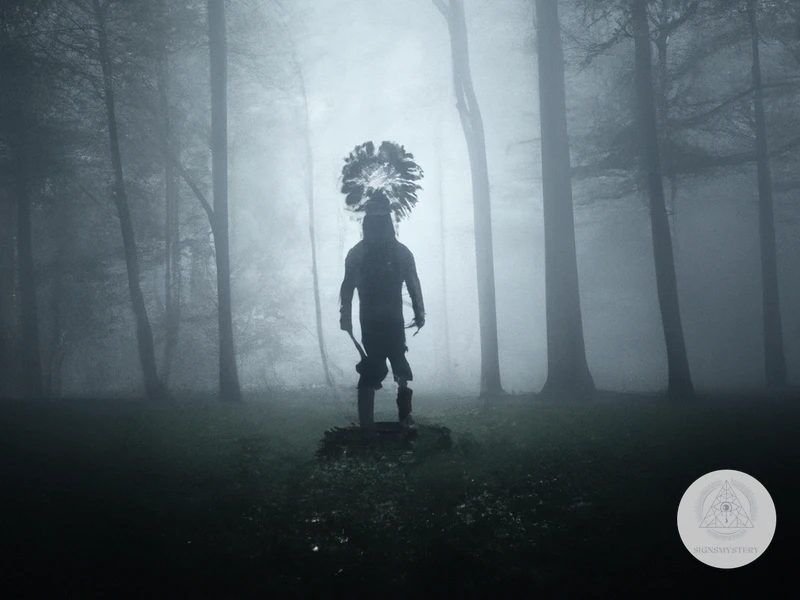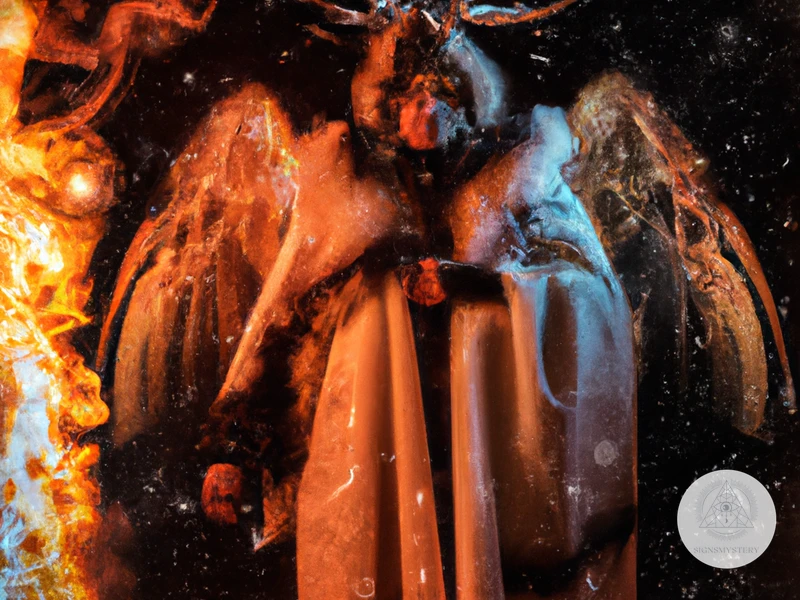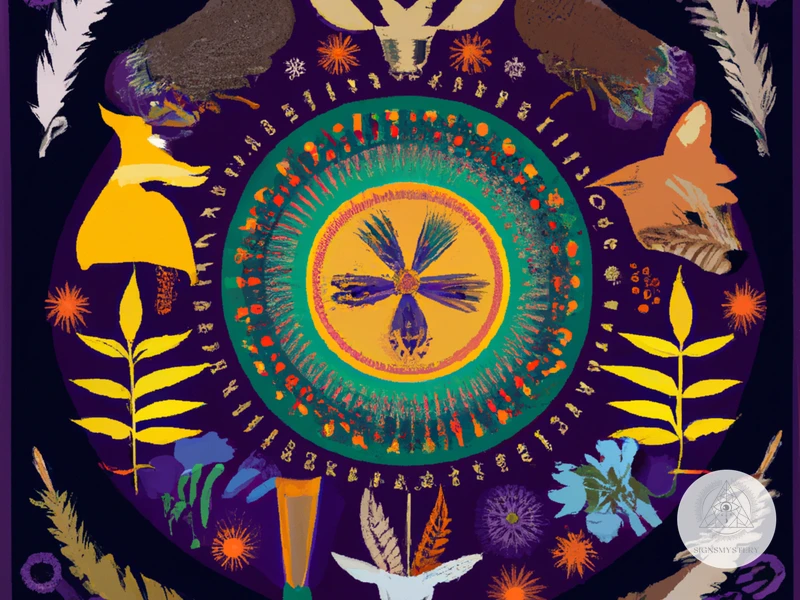Shamanism is a spiritual practice that has been around for centuries and is still practiced in various parts of the world. It involves a practitioner, known as a shaman, who can communicate with the spirit world and perform healing rituals. Myths play a significant role in shamanism, as they provide a framework for understanding the spiritual realm and the shaman’s role within it. In this article, we will explore the origins of Shamanism, the role of myths in shamanic practices, and compare and contrast shamanic myths across different cultures. Through examining the similarities and differences in these myths, we’ll gain a deeper understanding of the beliefs and practices that unite and differentiate various shamanic traditions. So let’s dive in and explore the fascinating world of shamanic myths.
What is Shamanism?

Shamanism is a spiritual practice that has existed for thousands of years across various cultures. It involves a shaman, who is a spiritual leader and intermediary between the physical world and the spiritual world. The shaman utilizes various practices, such as trance-inducing techniques and herbalism, to connect with the spiritual realm and provide healing, guidance, and protection for individuals and communities. Myths are an integral part of shamanism, serving as a source of wisdom, inspiration, and connection to the spiritual realm. These myths often contain symbolic meanings and archetypes that are common across cultures and help to create a sense of unity and understanding among diverse communities of shamanic practitioners. To understand more about the role of myths in shamanism, check out mythology in shamanism or symbolism in shamanic mythology.
Origins of Shamanism
The origins of Shamanism remain a mystery to this day. Scholars and experts cannot definitively pinpoint where Shamanism began. However, many experts speculate that its origins date back to Paleolithic times. Some believe that early human societies developed Shamanism as an attempt to create a spiritual connection with nature. Others believe that Shamanism grew out of early human societies’ attempts to control elements such as fire and water. It is challenging to determine the origins of Shamanism as they are closely intertwined with the time when humans first started developing myths and storytelling traditions.
Although the origins of Shamanism are not clear, researchers have found evidence of Shamanistic practices in various cultures worldwide. These practices are typically characterized by religious practices that involve a person (the shaman) who enters into a trance state to communicate with spirits and obtain their assistance. Some of these practices include performing ceremonial dances, chanting, and using hallucinogenic substances.
While the origin of Shamanism remains a mystery, it is clear that the practice has influenced many cultures worldwide. Shamanism has played a significant role in shaping many traditional storytelling and myth-making traditions. Myths and stories often feature Shamanic characters and practices. These stories have been used to help pass down knowledge and cultural beliefs from one generation to the next. More importantly, myths and stories play a crucial role in understanding the critical relationship between Shamanic mythology and religion.
Understanding the origins of Shamanism remains a challenge to experts in the field. However, the practices associated with Shamanism can be seen in cultures worldwide, highlighting the importance of this ancient and mysterious practice. Myths and storytelling traditions continue to be a valuable tool in exploring the deep connection between mythic archetypes and Shamanic practices, which have served as a way to understand the spiritual world and all its wonders.
Shamanic Practices
Shamanic practices are diverse and unique to each culture that practices them. However, there are certain practices that are universally recognized as shamanic practices. These practices include ritualistic ceremonies, trance induction, and communication with spirits.
| Shamanic Practice | Description |
|---|---|
| Ritualistic ceremonies | Shamans perform rituals and ceremonies to heal, impart wisdom, and bring balance to their communities. These ceremonies often involve music, dance, and the use of animal spirits to aid in the process. |
| Trance induction | Shamans induce a trance state to enter the spirit world and communicate with spirits. This is done through chanting, drumming, or other methods that alter the shaman’s consciousness. |
| Communication with spirits | Shamans communicate with spirits to gain knowledge, wisdom, and guidance. Spirits can take the form of animal spirits, ancestors, or other supernatural beings. |
Shamanic practices can be seen as a form of religion and mythology within many cultures. They provide a way for individuals to connect with the divine and gain insight into the mysteries of the universe. Additionally, shamanic practices often involve the use of natural remedies and techniques that can be beneficial for physical and mental health.
Shamanic practices are an integral part of shamanism across cultures. Although specifics may vary from culture to culture, the underlying principles and techniques remain the same. They provide a way for individuals to connect with the spiritual realm and gain insight and understanding of the world around them.
The Role of Myths in Shamanism
Myths play a significant role in shamanism. They are considered sacred stories and are used to explain the mysteries of life and the universe. Myths are also used as a means of connecting with the spiritual realm and the divine.
Shamans use myths as a tool for spiritual growth and healing. The stories help to provide insight into the human condition and offer guidance on how to live a fulfilling life. Myths are also used to teach moral lessons and cultural values.
In shamanism, myths are not seen as mere fables or tales. Instead, they are believed to hold great power and are treated with utmost respect. Myths are frequently used in ritual and ceremony and are believed to have the power to heal, protect, and transform.
One of the key roles played by myths in shamanism is their ability to bridge the gap between the physical and spiritual realms. They are used as a means of communicating with the spirit world and for connecting with the ancestors.
Myths are often viewed as living entities that continue to evolve and change over time. As such, they are open to interpretation and can be adapted to reflect the changing needs and beliefs of the community.
Myths are an essential part of shamanism and are used as a means of understanding the spiritual world, maintaining cultural identity, and promoting spiritual growth and healing. They are viewed as sacred stories with the power to heal, transform, and protect. If you want to learn more about shamanic myths and their interpretation, you can read our article “Interpreting Shamanic Myths Across Cultures”.
Comparing Shamanic Myths
The world of shamanic myths is vast and intriguing. Each culture has their unique stories revolving around creation, the underworld, animal spirits, and shamans’ spiritual journeys. A comparative study of these myths reveals the similarities and differences in beliefs, symbols, and rituals. For example, the myth of a great flood is prevalent in many cultures, including the Native American, Mesopotamian, and Hindu traditions. Similarly, the concept of the tree of life or the world tree is present in Nordic, Indian, and Siberian shamanic myths. On the other hand, while many Aboriginal cultures in Australia believe in ancestor spirits, other shamans in the Americas and South Asia focus on animal spirits. Studying the differences in mythology also leads to a better understanding of cultural values, norms, and customs.
Myths of Creation
are prevalent across many cultures that practiced Shamanism. These myths attempt to explain how the world came into existence and how humans first emerged. Even though the specific details vary from culture to culture, there are often common themes that unite these myths.
For example, many myths of creation involve some sort of divine being or spirit who creates the world and all that inhabits it. In many cultures, this spirit is seen as a great shaman who possesses the power to bring things into being. In other cases, the creation is the result of a battle between good and evil forces, or the product of a union between deities.
One common theme in many creation myths is the idea that the world was formed out of chaos or darkness. For example, in many Native American cultures, the world was created out of a primordial void. The Maya believed that the first humans were made out of maize, which grew in the darkness before it was illuminated by the sun.
In some cultures, there are also myths of a great flood that destroys the world, only to be reborn again through divine intervention or the actions of a powerful shaman. In other cultures, the creation of the world is seen as an ongoing process, with the shaman acting as the mediator between the human and spirit worlds.
The myths of creation are an essential part of shamanic cultures as they help to explain the existence of the world and humanity. While specific details may vary from culture to culture, there are often universal themes and messages that help to connect these myths across different populations and time periods.
Myths of the Underworld
Myths of the Underworld are prevalent in Shamanic cultures around the world. These myths often revolve around a journey into the underworld, and the challenges and trials that must be overcome to return to the world of the living. While the specifics of these myths differ between cultures, there are certain commonalities that can be found.
One common theme is the presence of a gatekeeper or guardian of the underworld. In the mythology of the ancient Greeks, this figure is often portrayed as Cerberus, the three-headed dog that guards the entrance to Hades. Similarly, the Maya of Central America believed in a god named Xibalba who ruled over the underworld and tested the souls of the dead.
Another common element in myths of the underworld is the concept of death and rebirth. In many Shamanic cultures, the journey through the underworld represents a metaphorical death and rebirth, wherein the traveler emerges from the underworld transformed and wiser. This theme can be seen in the Sumerian myth of Inanna, who descends into the underworld to confront her sister Ereshkigal. Through this journey, Inanna gains knowledge and power.
Shamans often use myths of the underworld to help individuals face their fears and overcome obstacles. In many cultures, the journey through the underworld is seen as a test of the traveler’s courage and strength. These myths can serve as a source of inspiration and guidance, helping individuals to overcome challenges and emerge stronger and more resilient.
The following table compares and contrasts myths of the underworld from different Shamanic cultures:
| Culture | Mythical Figures | Key Themes |
|——–|—————–|————|
| Ancient Greece | Cerberus, Hades | Death and rebirth, testing of the soul |
| Inca | Supay | Journey, transformation |
| Egyptian | Anubis, Osiris | Afterlife, judgment |
| Aborigine | Baiame | Journey, creation of the world |
| Hindu | Yama | Judgment, rebirth |
Despite the differences in specific figures and themes, myths of the underworld serve a unifying purpose in Shamanic cultures. They remind individuals that death is a natural and necessary part of life, and that overcoming obstacles and facing challenges are key to personal growth and transformation. The myths of the underworld continue to inspire and guide individuals on their spiritual journeys.
Myths of Animal Spirits
Myths of Animal Spirits have been an integral part of shamanic traditions across cultures, from ancient times to the present day. Animal spirits or totems are believed to be protectors, guides, and sources of power for shamans during their spiritual journeys, as well as for ordinary people in their everyday lives. The specific animals that are revered and their symbolism can vary widely depending on the cultural context.
In the Native American tradition, the bear is often considered a powerful and protective guardian spirit. It represents both courage and strength, as well as rest and introspection during hibernation. The eagle is another important animal spirit, associated with vision, keen observation, and spiritual ascent. Its feathers are prized for their symbolic value and used in sacred ceremonies and rituals.
In contrast, in the Korean shamanic tradition, the tiger is considered the supreme animal spirit that symbolizes power, vitality, and strength. According to traditional beliefs, Tigers have the ability to cure diseases and ward off evil spirits. Similarly, in the African shamanic tradition, the lion is a potent symbol of power, leadership, and protection. It represents the courage and perseverance needed to overcome obstacles and achieve one’s goals.
Other animal spirits that are common in shamanic myths include the snake, the wolf, the deer, the fox, the owl, and the horse, each with its own symbolism and significance. The snake, for example, is often associated with transformation and healing, while the wolf represents loyalty, teamwork and solidarity.
It is important to note that the symbolism of animal spirits in shamanic myths can vary widely even within a single culture depending on the context and interpretation. For example, while the snake is often associated with healing, it can also symbolize deceit and danger in some traditions. It is essential to understand the cultural and historical context of each myth to fully grasp its meaning and significance.
Myths of Animal Spirits are an essential part of shamanic traditions worldwide, highlighting the cultural differences and similarities in the way humans interact with animals. Through these myths, shamans seek inspiration and guidance from the natural world, and ordinary people find a connection to the universe that links humans and animals in a deep and profound way.
Myths of Shamans and Spiritual Journeys
Myths of Shamans and Spiritual Journeys are an integral part of shamanic traditions across cultures. In these myths, a shaman usually embarks on a spiritual journey to gain access to knowledge, power, or spiritual insight.
One common aspect of these myths is the presence of a spirit guide or animal spirit that assists the shaman on their journey. For example, in Native American traditions, the shaman may have a vision of an eagle or a bear who guides them through the spirit world. In African traditions, the shaman may have a vision of a lion or leopard.
Another common theme is the idea of transformation. In many myths, the shaman undergoes a transformation during their spiritual journey. They may take on the form of an animal or become more powerful through the acquisition of spiritual knowledge.
One of the most famous spiritual journey myths is that of the Siberian shamanic tradition. According to this myth, the shaman embarks on a journey to the upper or lower world to communicate with spirits that can help them heal, foretell the future, or gain supernatural powers.
Below are some examples of Shamanic Myths of Spiritual Journeys across different cultures:
| Culture | Myth |
|---|---|
| Native American | The Vision Quest |
| African | The Dancing Healers |
| Siberian | The Shaman’s Journey to the Spirit World |
| Australian Aboriginal | The Dreamtime |
As we can see, these myths share many similarities despite originating from different cultures. They all emphasize the importance of spiritual journeys and the acquisition of spiritual knowledge. However, there can also be differences in the specific practices and beliefs within these myths, highlighting the unique cultural context in which they originate.
Contrasting
Subscribe to Our Newsletter
Sign up to receive the latest news and updates.
Shamanic Myths
Subscribe to Our Newsletter
Sign up to receive the latest news and updates.

Shamanic myths differ across cultures due to various geographical and historical influences, cultural values and beliefs, and differences in interpretation and meaning. For example, while the Siberian shamanistic myth focuses on the role of ancestors and spirits in everyday life, the Native American mythology emphasizes the importance of balance and harmony with nature and the spirit world. Similarly, the African shamanistic myths highlight the connection between humans, animals, and the earth, while the Australian mythology centers around the Dreamtime and the creation of the world. These contrasting myths reveal the uniqueness of each shamanistic tradition and its underlying worldview, highlighting the profound and complex nature of shamanism as a spiritual practice and belief system that defies easy categorization or definition.
Geographical and Historical Influences
Geography and historical events have played a major role in shaping the content and interpretation of shamanic myths across cultures. The different geography, climate, flora, fauna, and landscapes of various regions have given rise to unique shamanic practices and beliefs.
For example, in the Arctic regions, shamanism often focuses on animal spirits, particularly those associated with the hunt. In contrast, in the rainforest regions, shamanism often revolves around plant and tree spirits that provide healing and medicinal properties.
Similarly, historical events have also left an imprint on shamanic myths. For instance, the arrival of colonial powers in many parts of the world had a profound impact on indigenous shamanic beliefs. The influence of Christianity led to the suppression of many shamanic practices, whereas syncretism resulted in the fusion of Christian and shamanistic elements in some cultures.
The migration of people and the resulting cultural exchanges have also influenced shamanic myths. For example, the nomadic tribes of Siberia encountered the Tungus people and their shamanic practices, which had a profound influence on the development of Siberian shamanism.
The aforementioned examples underscore the significant impact of geographical and historical influences on the development and diversity of shamanic myths across cultures. Thus, to understand and compare shamanic myths, it is imperative to consider these factors that have contributed to their evolution over time.
Cultural Values and Beliefs
Cultural values and beliefs play a significant role in shaping and distinguishing shamanic myths. Each culture brings its unique worldview, customs, and societal norms to the table, which can vary vastly from one another.
In Native American cultures, the myths often emphasize the close relationship between humans and nature. The animals are often seen as spirit guides and hold special symbolism. For instance, the bear is regarded as a powerful spirit associated with healing. In contrast, Africa’s shamanic myths stress the interconnection between the living and the dead. Ancestors are believed to watch over the present, and their spirits can be channeled through the shaman in rituals.
In many Asian cultures, the emphasis is placed on balance and harmony. The shamanic myths stress the importance of respecting nature and the cosmos as a way of bringing harmony to the human experience. In South America, shamanic myths reflect the cultural belief in the transformative power of psychedelics. Ayahuasca, a psychoactive brew used in South American shamanic rituals, is believed to facilitate deep spiritual introspection and physical healing.
The table below summarizes some key cultural values and beliefs that influence shamanic myths across different regions of the world:
| Region | Key Cultural Values | Examples of Shamanic Myths |
|---|---|---|
| Native America | Close relationship between humans and nature. Significance of animal spirits and symbolism. | The story of The White Buffalo Woman. The legend of the Raven and the creation of the world. |
| Africa | Interconnection between the living and the dead. Importance of ancestors and community. | The myth of Anansi the Spider. The story of the Sangoma and the calling of the spirits. |
| Asia | Emphasis on balance and harmony. Respect for nature and the cosmos. | The tale of the Monkey King and the journey to enlightenment. The myth of the Dragon and the importance of water. |
| South America | Belief in the transformative power of psychedelics. Importance of physical healing and spiritual introspection. | The legend of the Ayahuasca and the serpent. The story of the cactus and its ability to connect humans with the divine. |
As the table demonstrates, cultural values and beliefs have a significant impact on the development of shamanic myths. Despite the unique characteristics of each culture, there are common threads that tie shamanic practices and beliefs together, such as the emphasis on spiritual transformation, the importance of ritual and community, and the belief in the power of the natural world. An appreciation of cultural diversity and the different meanings behind shamanic myths can help individuals gain a more profound understanding of the rich tapestry of human experience.
Differences in Interpretation and Meaning
Shamanic myths vary not only in their content but also in their interpretation and meaning across different cultures. One example of this is the belief in animal spirits. In some cultures, certain animals may be seen as sacred and powerful guides for spiritual journeys, while in others they may be viewed as simple representations of particular traits or qualities.
Another example of differences in interpretation can be found in creation myths. In some cultures, creation is seen as a single act by a supreme being or deity, while in others it is viewed as an ongoing process that unfolds over time.
These differences in interpretation can often be attributed to the unique cultural values and beliefs of each society. For example, the role of the shaman may be viewed differently in cultures where the individual is seen as less important than the community as a whole compared to societies where individualism is highly valued.
To illustrate these differences, let’s compare two myths of the underworld. In Greek mythology, the underworld is viewed as a cold and dreary place where souls go after death. However, in some Indigenous Australian cultures, the underworld is seen as a place of warmth and rebirth, where spirits go to be healed before being reincarnated into the world above. These interpretations reflect the cultural values of each society, as the Greeks placed a strong emphasis on the concept of a final judgement, while healing and rebirth are highly valued in many Indigenous Australian cultures.
Ultimately, these differences in interpretation and meaning demonstrate the flexibility and adaptability of shamanic myths in meeting the needs and beliefs of different cultures. By embracing and celebrating these differences, we can appreciate the rich diversity of shamanic traditions around the world and the unique perspectives they offer on the human experience.
| Myths | Cultures | Interpretation |
| — | — | — |
| Animal spirits | Native American | Spiritual guides |
| Animal spirits | Chinese | Symbols of traits |
| Creation | Greek | Single act by deity |
| Creation | Indigenous Australians | Ongoing process |
| Underworld | Greek | Cold and dreary |
| Underworld | Indigenous Australians | Warm and healing |
Myths as a Unifying Force in Shamanism
Shamanism, despite its diverse practices and beliefs, shares a common thread of mythology across various cultures. Myths serve as a unifying force in shamanism, connecting practitioners through shared stories and ideas.
Through the retelling of myths, shamans pass down valuable knowledge and insights about their culture, history, and beliefs. This helps to maintain the continuity of shamanism across generations and reinforces the idea of a shared spiritual ancestry.
Myths provide a sense of belonging and identity to shamans regardless of their cultural backgrounds. For example, the myth of the world tree, found in many shamanic cultures, symbolizes the axis mundi- the connecting point between the physical and spiritual realms. Similarly, the serpent is a common symbol in shamanism, representing the cycle of life and death and the shedding of old ways for new growth.
Apart from cultural diversity, shamanic myths also act as a unifying factor in terms of practical applications. For example, the shamanic journey- an important focus in shamanism- is essentially the same across cultures, despite differences in language and cultural context. This standardization of shamanic practices allows practitioners to share experiences and knowledge more effectively.
Shamanic myths are a powerful tool for unifying shamanism across cultures and connecting practitioners through their shared spiritual heritage. By sharing these myths, shamans maintain the continuity of shamanic practices, build a sense of belonging and identity, and create a standardized system for practical applications. Myths are an essential component of shamanism, and their role in unifying this spiritual practice cannot be overstated.
Conclusion
After exploring the diverse range of shamanic myths across cultures, it is clear that despite the surface level differences, there are common threads that tie them together. Myths of creation, the underworld, animal spirits, and shamanic journeys all reveal a belief in a spiritual world that exists beyond our physical reality. This world is accessible through shamanic practices, and provides an opportunity for transformation, healing, and growth.
While there are certainly differences in the interpretation and meaning of these myths based on geographic and cultural influences, they ultimately share a common purpose: to provide a unifying force for shamanic communities. As Joseph Campbell famously said, “Myth is the secret opening through which the inexhaustible energies of the cosmos pour into human cultural manifestation.”
By exploring and comparing shamanic myths, we gain a greater appreciation for the diversity of human thought and experience. We understand that stories provide a way for us to connect with the spiritual realm, explore the mysteries of the universe, and ultimately bring meaning into our lives. As such, shamanic myths continue to be an important source of inspiration and guidance for those on a spiritual journey.
In conclusion, while the study of shamanic myths is complex and multifaceted, it is also deeply rewarding. By examining the similarities and differences across cultures, we gain a greater understanding of our shared human experience. As we continue to explore shamanic practices and the myths that surround them, we will undoubtedly uncover new insights and wisdom that will help us on our own spiritual journeys.
Frequently Asked Questions
What is the main goal of shamanism?
The main goal of shamanism is to allow individuals to connect with the spiritual world and harness its power for the betterment of themselves and their communities.
What is the definition of a shaman?
A shaman is a spiritual healer and guide who is able to move between the physical and spiritual worlds to facilitate healing, divination, and communication with the divine.
Are shamanic myths influenced by geography?
Yes, shamanic myths are heavily influenced by geography, as different regions have their own unique natural landscapes, animal populations, and cultural traditions that shape their mythology.
What role do animal spirits play in shamanic myths?
Animal spirits are often believed to be powerful allies and guides for shamans, who use them as sources of spiritual power and wisdom.
How are shamanic myths passed down through generations?
Shamanic myths are often passed down through oral traditions, with stories and rituals being passed down from one generation to the next through song, dance, and other forms of communal expression.
What is the significance of spiritual journeys in shamanic myths?
Spiritual journeys are believed to be a means by which shamans can connect with the divine and receive insights and wisdom beyond what is available in the physical world.
What differentiates shamanic myths from other religious myths?
Shamanic myths tend to be more focused on the spiritual world and the power of individuals to connect with it, rather than on religious doctrine or theology.
How do shamanic myths contribute to social cohesion within communities?
Shamanic myths can help to establish shared cultural values and beliefs, as well as promoting a sense of interconnectedness between individuals and the natural world.
Are there any common themes that appear in shamanic myths across cultures?
Yes, many shamanic myths share common themes such as the creation of the world, the importance of animal spirits, and the use of spiritual journeys to connect with the divine.
Do shamanic myths still play a role in modern society?
Yes, shamanic myths and practices still play an important role in many cultures today, as people seek ways to connect with the spiritual world and harness its power for healing and personal growth.










